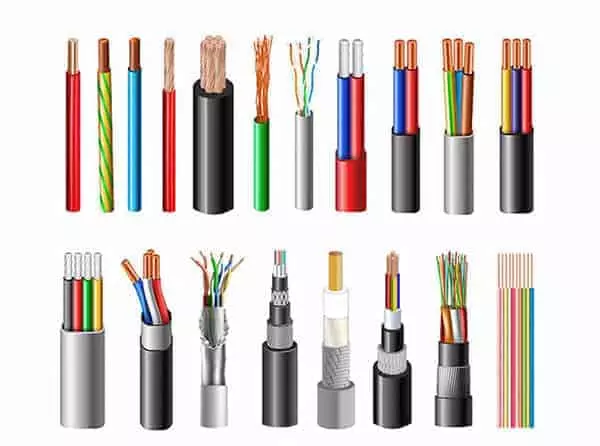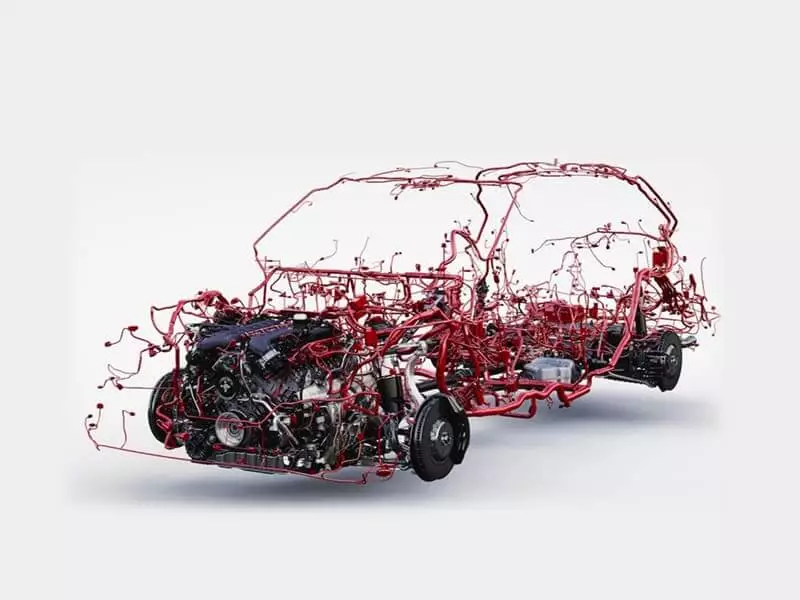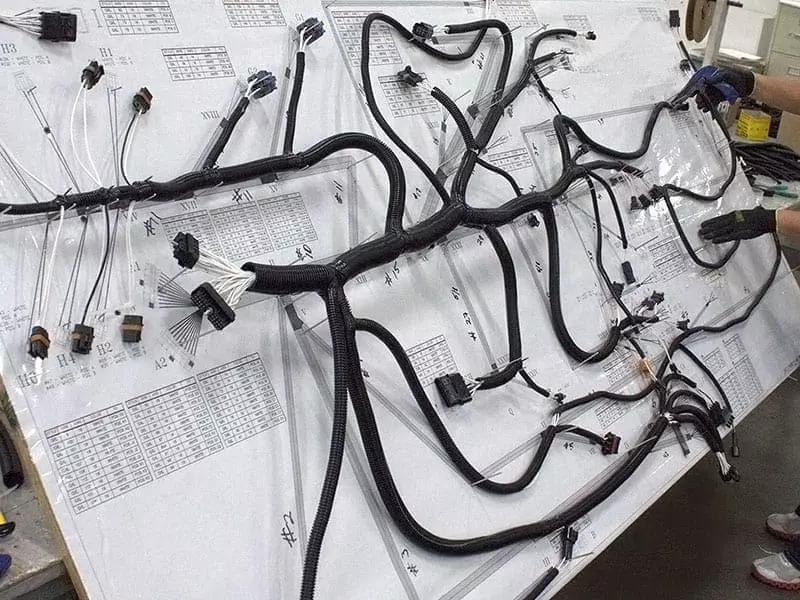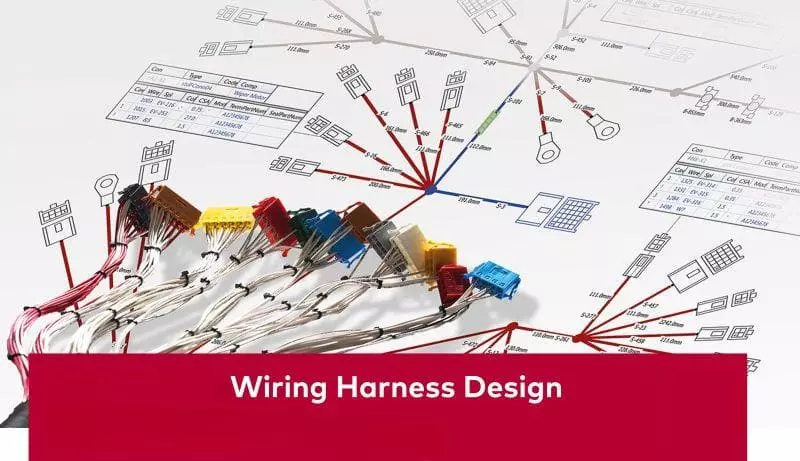Why are flat ethernet cables bad?Why are flat Ethernet cables considered inferior to traditional round ones? As home broadband upgrades and corporate demand for high-speed networks grow, more users are recognizing how cabling materials impact network performance and long-term stability. While flat cables appear appealing due to their slim profile, concealability, and ease of installation, they often exhibit significant shortcomings in electrical performance, durability, and standard compliance.
This article will delve into the limitations of flat Ethernet cables through structural design, performance comparisons, application scenarios, and industry standards. By examining real-world cases, it aims to guide you toward making scientifically informed network cabling decisions.
What is Flat Ethernet Cable?
Flat Ethernet Cable, as the name suggests, is a network cable featuring multiple conductors arranged in parallel and encased in insulation to form a ribbon-like structure. Unlike conventional round network cables, its geometric design makes it thinner, lighter, and more flexible. It can easily be routed along walls, under carpets, or behind furniture, enabling concealed wiring and space-saving installation.
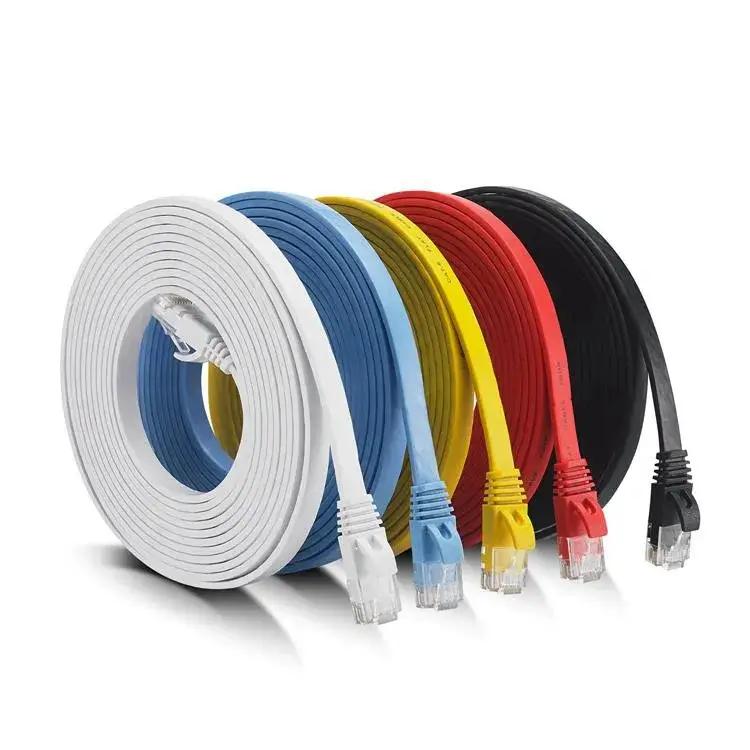
Typically utilizing fine 28–32 AWG gauge wires, flat cables boast minimal overall thickness and lightweight construction. This allows users to complete network installations without compromising interior aesthetics. However, this structure also implies potential limitations in mechanical durability, shielding effectiveness, and long-distance transmission stability compared to round cables. Consequently, flat cables are more suitable for short-distance home wiring or temporary network connections, rather than enterprise-grade or data center scenarios demanding high bandwidth, extended lifespan, and strict compliance.
Differences Between Flat and Round Ethernet Cables
| Aspect | Flat Ethernet Cable | Round Ethernet Cable |
|---|---|---|
| Structure | Parallel conductors in a flat ribbon design; thin, flexible, easy to hide | Twisted pairs inside a round jacket; often with fillers and shielding, more robust |
| Electrical Performance | Less consistent twists, poor impedance control, weaker EMI resistance, limited for long-distance | Precise twists, stable impedance, supports higher bandwidth and longer runs |
| Durability | Prone to damage from bending, foot traffic, or pressure; shorter lifespan | Stronger jacket with fillers, resists tension and abrasion, longer lifespan |
| PoE Capability | Typically thin conductors (28–32 AWG), more heat and voltage drop under high PoE | Thicker conductors (23–24 AWG), supports PoE++ (90W) reliably |
| Applications | Short-distance, hidden cabling at home or office | Enterprise networks, data centers, industrial wiring, permanent installations |
Why are Flat Ethernet Cables bad?
Although flat Ethernet cables are favored by some users for their slim profile and concealability, they are often regarded as an “unreliable” choice in engineering and professional applications.
The primary issues with flat Ethernet cables center on five key areas: durability, electrical performance, PoE capability, thermal lifespan, and compliance. These shortcomings limit their use in high-performance, long-term, and standardized cabling installations.
1. Insufficient Mechanical Durability
The geometric structure of flat cables inherently lacks internal fillers and reinforcement layers, resulting in significantly lower resistance to external pressure compared to round cables. During prolonged use, they are prone to conductor breakage or insulation damage due to bending, stepping, pulling, or compression.
For instance, placing flat cables under office chair casters or beneath carpets can cause frequent friction that easily fractures internal conductors. This renders them unsuitable for cabling environments requiring long-term fixed installations and high-intensity mechanical protection.
2. Unstable Electrical Performance
Ethernet transmission relies on the precision of twisted-pair cables to counteract electromagnetic interference and maintain impedance consistency. However, in flat cables, space constraints result in less uniform twist rates for twisted pairs compared to round cables, making crosstalk and signal reflections more likely to occur. This issue particularly manifests during high-speed transmission at Gigabit (1Gbps) or 10 Gigabit (10Gbps) rates, causing bandwidth degradation, increased latency, and even data packet loss. Consequently, flat cables are generally recommended only for low-speed, short-distance connections.
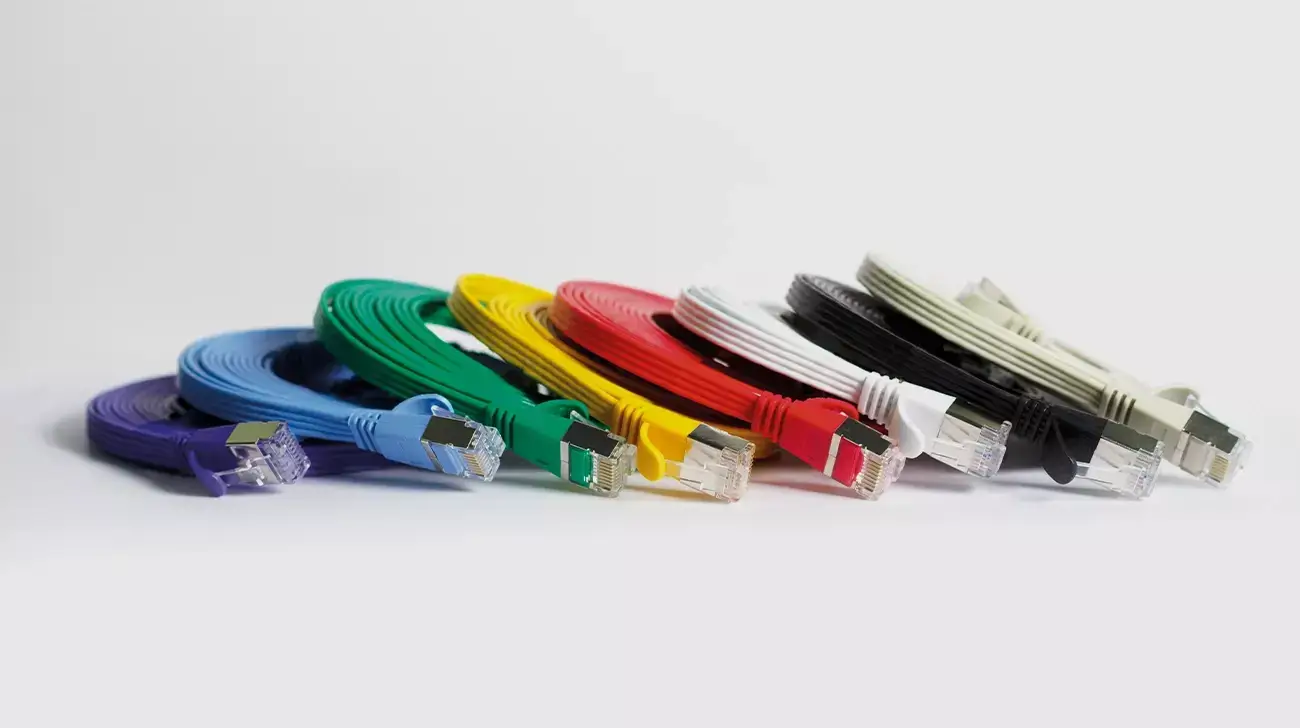
3. Limited PoE Capability
Flat cables commonly use thin 28–32 AWG conductors, whose cross-sectional area is significantly smaller than conventional 23–24 AWG round cables, resulting in higher resistance. When transmitting PoE or PoE++ power (up to 90W), the thin gauge causes more pronounced voltage drops and heat generation. Under high-load conditions, issues such as unstable operation of powered devices and accelerated insulation degradation may occur. This renders flat cables unsuitable for applications requiring long-distance power delivery, such as wireless access points, IP cameras, or building intercom systems.
4. Heat Dissipation and Lifespan Concerns
Beyond high resistance, flat cables’ large surface area and narrow conductor spacing make them prone to heat accumulation in dense cabling environments. Prolonged high-load operation elevates cable temperatures, causing insulation softening and material degradation that shortens service life. In enterprise or data center settings, thermal management is a critical cabling design factor, and flat cables often fail to meet long-term operational requirements.
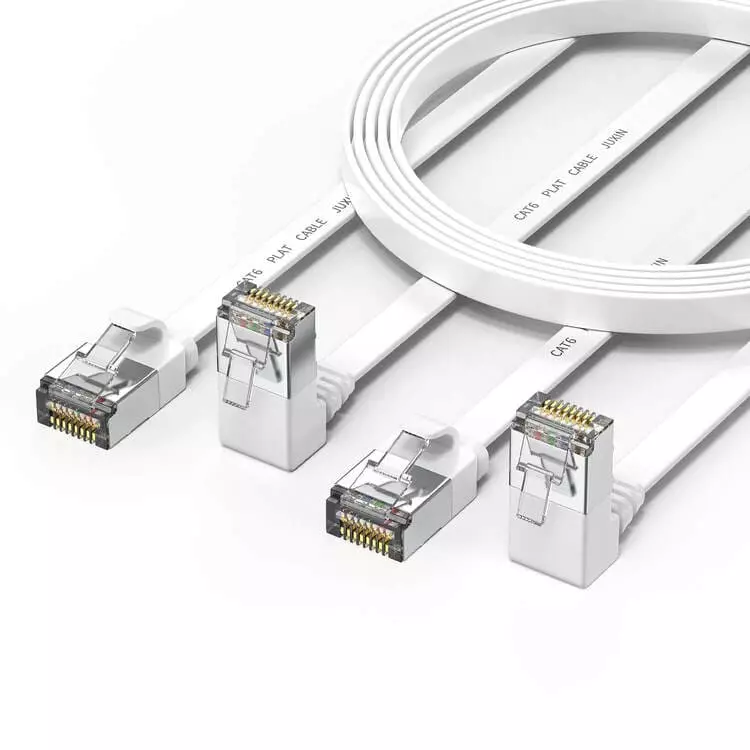
5. Lack of Standards and Compliance
Most flat Ethernet cables lack certification under mainstream cabling standards, including:
- TIA/EIA-568 (Commercial Building Cabling Standard)
- UL/NEC (Safety and Flame Retardant Ratings)
- ISO/IEC 11801 (International Integrated Cabling Standard)
The absence of these certifications means they cannot be used as permanent links and will fail engineering acceptance. This explains why flat cables are virtually absent in professional cabling environments like enterprise networks, data centers, and industrial facilities.
When Flat Cables Work?
- Home Networking: Ideal for short-range connections to routers, TVs, or gaming consoles, offering concealed and aesthetically pleasing cabling.
- Small Offices: Enables rapid network deployment in temporary workspaces without damaging interior finishes.
- Temporary Cabling: Facilitates quick installation and removal for exhibitions, events, or laboratory testing.
- High Concealment Needs: Designed for homes or offices prioritizing clean, uncluttered aesthetics, achieving near-invisibility.

Why Round Cables Are Better?
1) Enhanced Structural Durability
- Circular Geometry + Internal Filling: Round cables typically incorporate fillers or cross separators to isolate twisted pairs, distribute external forces, and resist flattening, stretching, and twisting. Flat cables lack these structures, making them more prone to stress concentration at impact/folding points and copper core fatigue.
- Jacket and Materials: Common PVC/PE/LSZH outer jackets offer superior abrasion and cut resistance. Industrial/outdoor variants may feature PUR, UV-resistant, or oil-resistant formulations, delivering better environmental impact resistance than flat cables.
- Bending Radius Specifications: TIA recommends UTP bending radius ≥4×outer diameter (shielded cable ≥10×outer diameter). Round cables facilitate easier routing within compliant radii and exhibit higher contact reliability after prolonged repeated bending.
- Practical Recommendations: Prioritize round cables for fixed installations in cable trays, racks, cabinets, and in-wall conduits. Where placement under carpets or door thresholds is unavoidable, use low-profile cable trays or protective plates to prevent direct foot traffic.

2) More stable electrical performance
- Twist Pitch and Impedance Control: Round cables maintain uniform twist pitch and balanced 100 Ω impedance more effectively, reducing return loss (RL) and near/far end crosstalk. Flat cables inherently suffer from geometric inconsistencies, with issues amplified at higher speeds or longer distances.
- Category and Bandwidth: Compliant Cat6/Cat6A round cables meet link requirements for 1G/10G up to 100 m and employ proven alien crosstalk suppression methods (e.g., skeleton, larger outer diameter, twisted pair management).
- Pair Skew and Latency Skew: Round cables offer superior geometric/electrical consistency between twisted pairs, resulting in lower inter-pair latency skew and more reliable eye margin for high-speed differential signals.
- Practical Recommendations: For long distances (>20–30 m) at ≥1 Gbps or 10G applications, prioritize Cat6A round cables. Compliant patch cords are also recommended for short chassis/cabinet jumps to maintain upgrade headroom.
3) Supports high-power PoE
- Wire Gauge and Resistance: Round cables typically use 23–24 AWG solid wire, offering lower DC resistance and reduced voltage drop. Flat patch cables often employ 28–32 AWG, resulting in significant temperature rise during long-distance/high-power applications.
- PoE Standard Compatibility: Round cables better support 802.3af/at/bt (PoE/PoE+/PoE++), with Type 3/4 (bt) reaching up to 60/90 W. Under bt, current per pair significantly increases, making it more sensitive to conductor resistance, temperature rise, and harness heating.
- Bundling and Temperature Rise: Follow TIA TSB-184-A / ISO/IEC TR 29125 guidelines for bundle power dissipation and temperature rise management. Round cables offer larger outer diameters and more controllable heat dissipation, making them suitable for high-density PoE deployments.
- Practical Recommendations: Use round cables for long-distance power delivery to PoE devices like wireless APs, IP cameras, access control systems, and phones. Avoid high-power PoE or limit flat patch cables to very short end-of-line connections.

4) Superior Thermal Management & Longevity
- Thermal Pathways & Material Stability: The cross-section and internal structure of round cables facilitate heat dissipation. Under high-bandwidth + PoE combined conditions, they operate at lower temperatures, resulting in slower insulation and sheath aging and extended service life.
- Bundling and Conduit Installation: Within cable trays/ducts/bundles, round cables are engineered for fill rates and thermal specifications, better controlling cumulative temperature rise. Flat cables are more prone to hotspots in dense environments.
- Reliability and Maintenance: Lower temperatures minimize contact resistance drift and dielectric loss, ensuring more stable link metrics. Round cables facilitate long-term acceptance testing and periodic inspections.
- Practical Recommendations: For high-density connectivity, sustained full-load operation, or elevated ambient temperatures, uniformly select round cables while adhering to standard guidelines for bundle sizing and ventilation.
How to Choose the Right Ethernet Cable?
Selecting an Ethernet cable involves more than just choosing between flat or round. It requires a comprehensive assessment based on bandwidth requirements, power delivery needs, cabling environment, and compliance standards. Here are several key considerations:
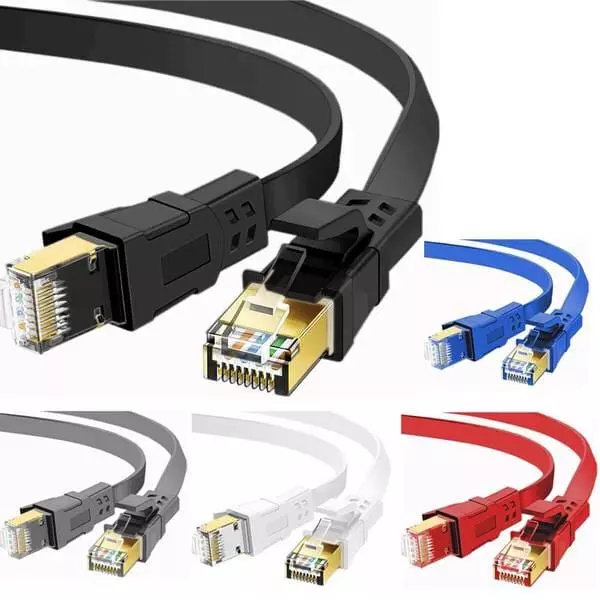
1. Usage Environment
- Home or temporary cabling: For short distances where aesthetics are prioritized, Flat Ethernet Cable is suitable.
- Enterprise, data center, or industrial environments: Where durability, stability, and standard compliance are paramount, Round Ethernet Cable must be used, meeting standards such as TIA/EIA and UL.
2. Bandwidth Requirements
- 100Mbps/1Gbps: Cat5e or Cat6 round cable suffices for most office and home applications.
- 10Gbps and above: Cat6A or Cat7/7A round cable is recommended to ensure performance and stability over long distances.
3. Power Requirements (PoE Applications)
- Low-power devices (e.g., VoIP phones, small cameras): Standard Cat5e or Cat6 is sufficient.
- High-power devices (e.g., wireless APs, PoE cameras, building systems): Must select 23–24 AWG round cable to ensure voltage drop and temperature rise remain within safe limits.
4. Environmental Factors
- Standard indoor environments: Common PVC or LSZH outer jackets are adequate.
- High-temperature/humid/outdoor: Select industrial-grade or outdoor round cables with UV resistance, waterproofing, oil resistance, or flame-retardant ratings.
5. Cost and Long-Term Value
- Flat Cable: Low cost and easy installation, suitable for temporary or short-term use.
- Round Cable: Slightly higher initial cost but longer lifespan and more stable performance, resulting in lower overall long-term costs.
FAQs
Q1: Can Flat Ethernet Cable be used for permanent cabling?
A1: Not recommended. Most flat cables lack certification from standards like TIA/EIA or UL, making them unsuitable for engineering-grade permanent links.
Q2: Is Flat Ethernet Cable suitable for temporary home use?
A2: Yes. Flat cables are lightweight and flexible, ideal for short-distance home installations prioritizing aesthetics, but not for long-term reliance.
Q3: When is Round Ethernet Cable mandatory?
A3: Standard-compliant round cables are required for long-distance transmission, high bandwidth, PoE power delivery, industrial applications, or data center cabling.
Conclusion
In summary, flat Ethernet cables are not inherently “bad”; they do offer advantages for short-distance, temporary, and aesthetically driven installations. However, when evaluated for mechanical durability, electrical performance, PoE capability, heat dissipation, and standards compliance, flat cables exhibit significant shortcomings. They cannot meet the demands for high performance and long-term reliability required in enterprise networks, data centers, or industrial environments. In contrast, Round Ethernet Cables are better suited for long-term and professional applications, serving as the preferred choice for secure and stable deployments.
If you are evaluating network cabling solutions, Linkwings can provide standardized and customized Ethernet Cable solutions—from residential to data center environments—tailored to your bandwidth, power delivery, and installation requirements. We help you achieve optimal network performance and reliability.
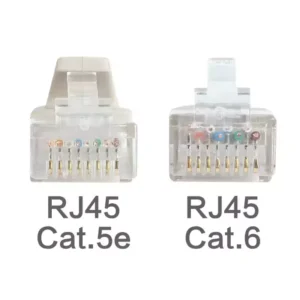
What is the Difference Between Cat5e and Cat6 RJ45 Connectors?
Table of Contents Wh
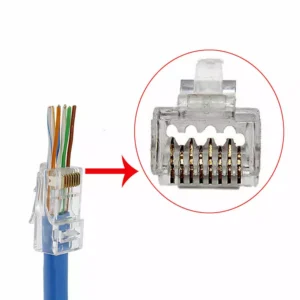
What is RJ45 Connector?
Table of Contents In
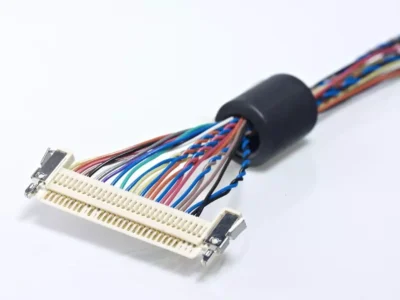
Top 10 LVDS Cable Manufacturers in World 2026
Table of Contents In

How to Check Lvds Cable?
Table of Contents In

